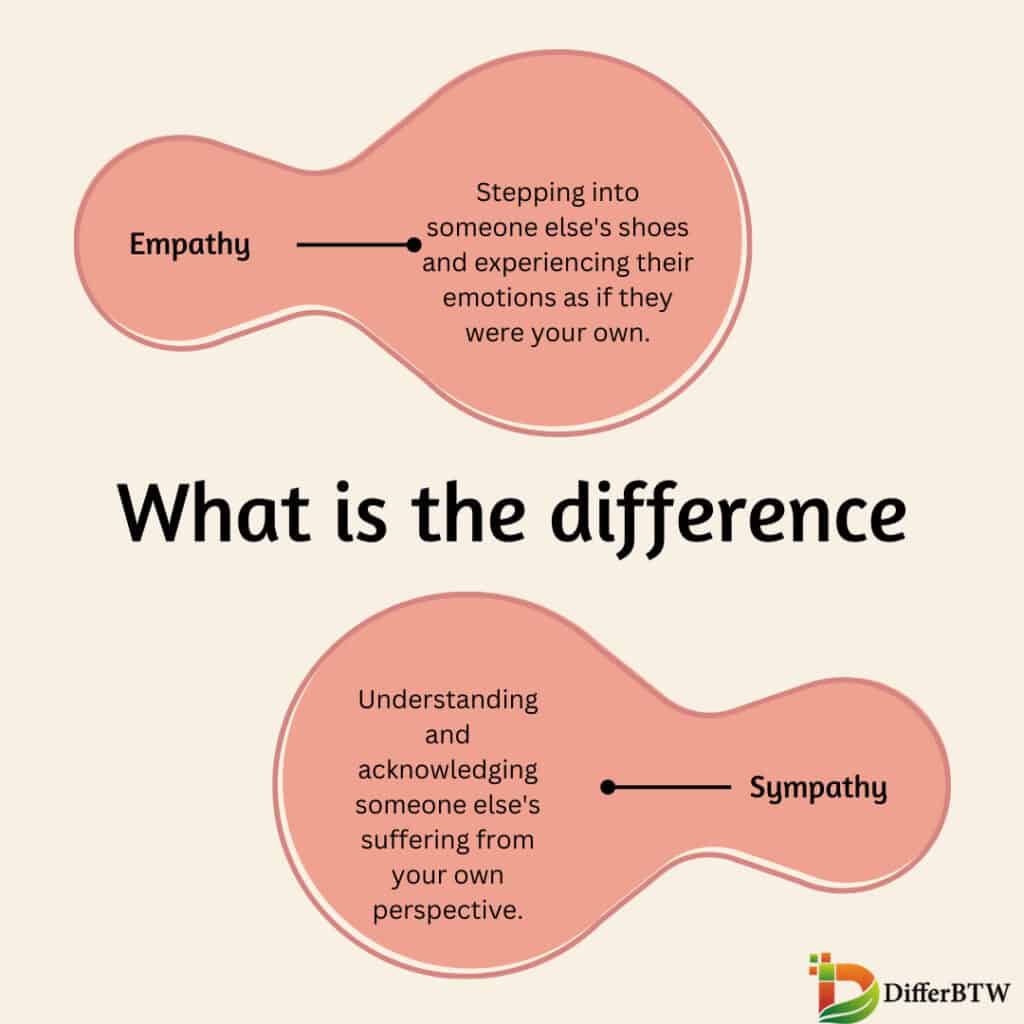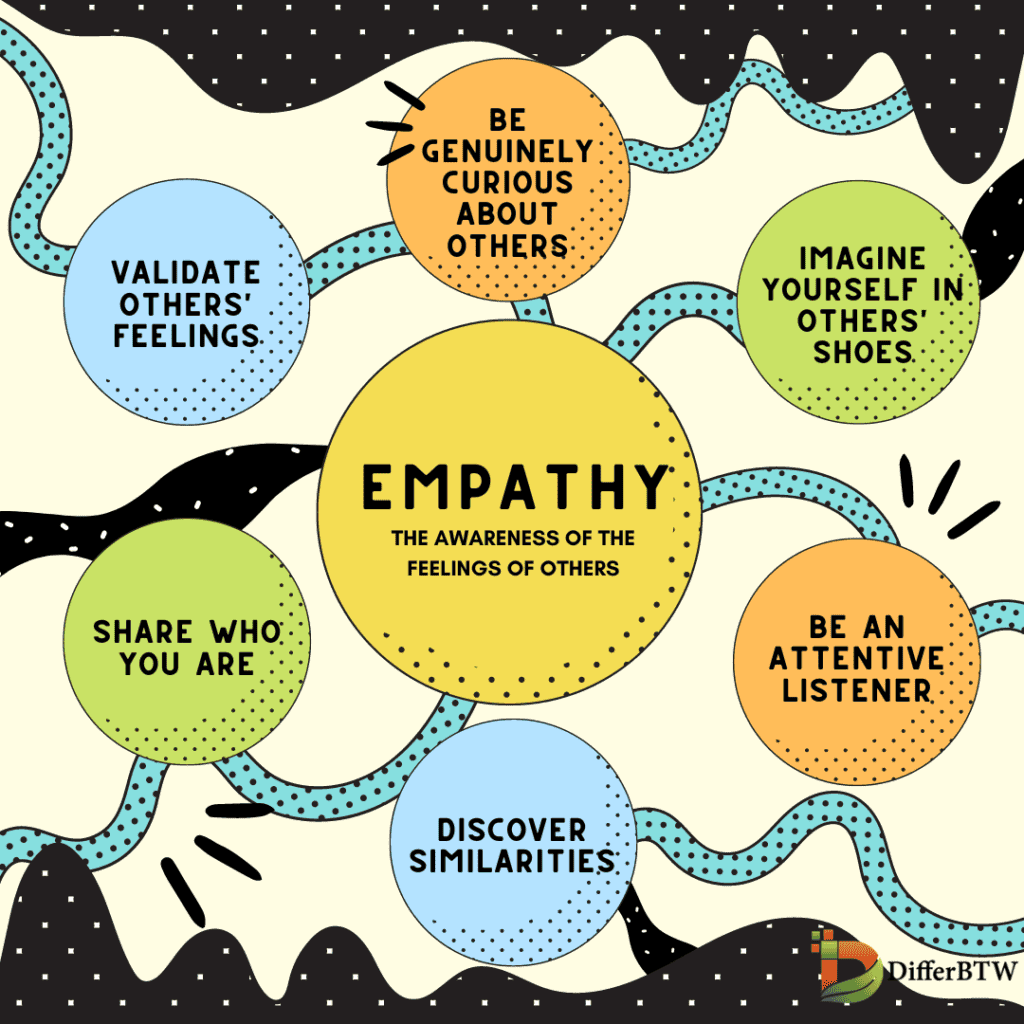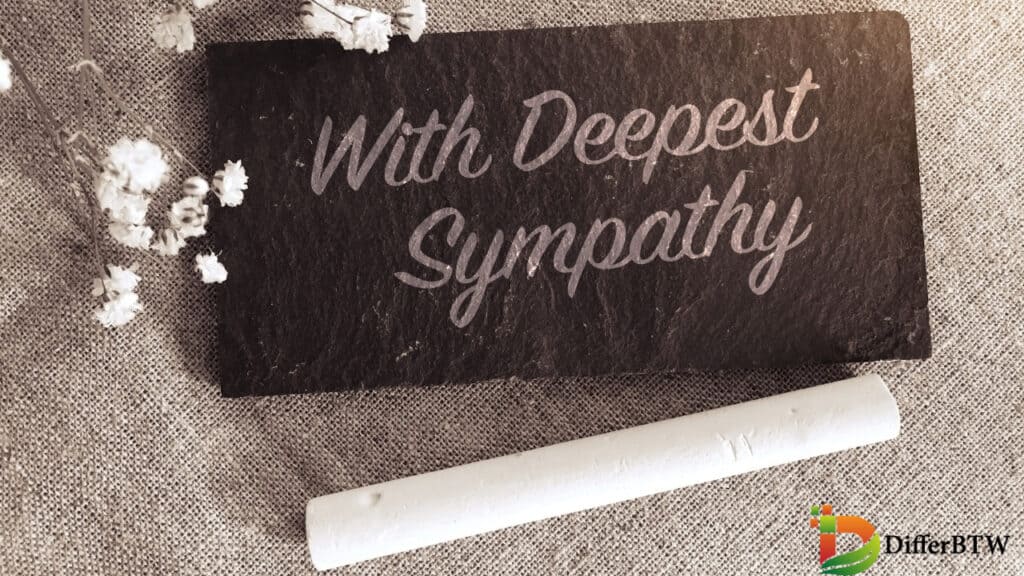Empathy and sympathy may seem similar at first glance, but they’re fundamentally different aspects of human connection. When I empathize with someone, I truly understand and share their feelings, stepping into their shoes to experience their emotions firsthand. It’s like feeling their pain as if it were my own, fostering a deep sense of connection and understanding.
On the other hand, sympathy involves acknowledging someone else’s emotions without necessarily feeling them myself. While sympathy involves compassion and concern for others, it doesn’t necessarily require the same level of emotional immersion as empathy does.

Comparison Chart
| Parameter of Comparison | Empathy | Sympathy |
|---|---|---|
| Definition | Stepping into someone else’s shoes and experiencing their emotions as if they were your own. | Understanding and acknowledging someone else’s suffering from your own perspective. |
| Emotional Engagement | Deep – you feel the other person’s emotions. | Superficial – you care about their feelings, but don’t necessarily share them. |
| Perspective Taking | Highly developed – you see the world through their eyes. | Moderately developed – you understand their situation based on your own experiences. |
| Connection | Deeper and more intimate due to shared emotional experience. | Supportive but maintains a distance. |
| Response | More nuanced and tailored to the individual’s needs. | May involve offering words of comfort or support. |
| Example | “I feel so sad for you. Losing a pet is really hard.” (Feeling their sadness) | “That must be awful. Let me know if you need anything.” (Understanding their pain) |
What is Empathy?
Empathy is the capacity to understand or feel what another person is experiencing from within the other person’s frame of reference, i.e., the capacity to place oneself in another’s shoes. Empathy is seeing with the eyes of another, listening with the ears of another, and feeling with the heart of another. Empathy is thought to be a fundamental human emotion. But research suggests that the ability to empathize with others is not evenly distributed throughout the population: some people seem to be more empathetic than others, and this capacity can vary depending on the situation.
Empathy is the ability to understand what another person is feeling. Empathy is the capacity to understand or feel what another person is experiencing from within the other person’s frame of reference, i.e., the capacity to place oneself in another’s shoes. Empathy is seeing with the eyes of another, listening with the ears of another, and feeling with the heart of another. Empathy is thought to be a fundamental human emotion, and it is essential to relationships.
Types of Empathy
There are several types of empathy, including cognitive empathy, emotional empathy, and compassionate empathy. Cognitive empathy involves understanding another person’s perspective intellectually, while emotional empathy involves feeling what they feel on an emotional level. Compassionate empathy takes it a step further by not only understanding and feeling but also being motivated to take action to alleviate the other person’s suffering or distress.
Developing Empathy
Empathy is a skill that can be cultivated and strengthened over time. It requires active listening, paying attention to nonverbal cues, and practicing perspective-taking. Engaging in activities that promote empathy, such as volunteering, participating in group discussions, or simply having meaningful conversations with others, can help sharpen this skill. Personally, I’ve found that the more I practice empathy, the easier it becomes to connect with others on a deeper level and understand their experiences.
Empathy and Communication
Empathy plays a vital role in effective communication. When we empathize with others, we are better able to communicate with sensitivity and understanding. It allows us to tailor our messages to the needs and emotions of the other person, leading to more meaningful and productive interactions. In my own interactions, I’ve noticed that when I approach conversations with empathy, I’m able to navigate conflicts more effectively and build stronger connections with others.

Examples of Empathy
- Putting yourself in someone else’s shoes: Empathy involves imagining what it would feel like to be in another person’s situation. For example, if a friend is going through a breakup, empathizing with them means trying to understand and share their feelings of heartache.
- Offering a hug: A simple hug can convey empathy by providing comfort and reassurance. Physical touch can help someone feel understood and supported during times of distress.
- Sharing a personal story: Sharing a personal experience similar to what someone else is going through can demonstrate empathy. It shows that you understand their emotions because you’ve been through something similar yourself.
- Expressing genuine concern: Asking someone how they’re feeling and genuinely caring about their response is an empathetic gesture. It shows that you value their emotions and want to support them through their struggles.
- Helping without being asked: Anticipating someone’s needs and offering help without them having to ask is a way to show empathy. Whether it’s bringing over a meal when a friend is sick or offering to run errands for a busy colleague, these actions demonstrate understanding and compassion.
What is Sympathy?
Sympathy is the ability to understand or share the feelings of another. The term sympathy is derived from the Greek word sym meaning with, together and pathos meaning feeling, suffering.
Sympathy is the emotion we feel when we perceive another’s emotional or physical pain and feel compelled to help. Empathy is confused with sympathy, but they are two distinct emotions. Sympathy is feeling compassion, sorrow, or pity for someone else in their misfortune. Empathy is the capacity to understand or feel what another person is experiencing from within the other person’s frame of reference, i.e., the capacity to place oneself in another’s position.
Expressing Sympathy
Expressing sympathy can take many forms, depending on the situation and the individual’s preferences. It might involve offering comforting words, giving a thoughtful gift, or simply being present to listen and provide support. The key is to show genuine care and concern for the other person’s well-being. In my experience, a heartfelt gesture or a kind word can make a world of difference to someone who is going through a difficult time.
Cultivating Sympathy
Sympathy is a quality that can be cultivated and nurtured over time. It requires developing a heightened awareness of others’ emotions and actively practicing empathy. Engaging in acts of kindness and volunteering can also help strengthen your capacity for sympathy. being open-minded and non-judgmental allows you to better connect with others and offer meaningful support when needed.
The Importance of Sympathy
Sympathy plays a crucial role in fostering meaningful connections and building strong relationships. When we show sympathy towards others, we create a sense of trust and mutual understanding. It helps bridge the gap between individuals and promotes a sense of unity and belonging. Moreover, receiving sympathy during challenging times can provide much-needed comfort and reassurance, reminding us that we are not alone in our struggles.

Examples of Sympathy
- Sending flowers to a grieving friend: When someone experiences a loss, such as the death of a loved one, sending flowers is a common way to show sympathy. It’s a gesture that communicates your support and care during their difficult time.
- Donating to a charity: When a natural disaster strikes or a community faces hardship, donating to a charity is a way to express sympathy. It shows that you empathize with those affected and want to help alleviate their suffering.
- Offering condolences: Taking the time to express condolences, whether in person, through a card, or via a message, demonstrates sympathy. It lets the person know that you recognize their pain and are there for them.
- Attending a funeral: Attending a funeral or memorial service is a tangible way to show sympathy to the bereaved. Your presence provides comfort and support during a difficult time.
- Listening attentively: Sometimes, all someone needs is a listening ear. Offering your time and attention to listen to someone talk about their struggles or challenges shows sympathy and validates their emotions.
Difference Between Sympathy and Empathy
- Understanding the Emotion:
- Empathy involves understanding and sharing the feelings of another person. It’s like stepping into someone else’s shoes and experiencing their emotions firsthand. For example, if a friend is going through a tough breakup, you might feel their pain as if it were your own.
- Sympathy, on the other hand, is acknowledging another person’s feelings without necessarily experiencing them yourself. You recognize that they’re going through a difficult time, but you don’t necessarily feel their emotions as deeply. You might offer words of comfort or support without fully immersing yourself in their perspective.
- Connection vs. Distance:
- Empathy creates a strong emotional connection between individuals. When you empathize with someone, you forge a bond based on shared emotions and experiences. This can deepen your relationship and foster trust and understanding.
- Sympathy maintains a certain degree of emotional distance. While you may offer support and kindness, there’s still a sense of separation between your feelings and those of the other person. This can sometimes lead to a less intimate connection compared to empathy.
- Validation of Feelings:
- Empathy validates the other person’s feelings by fully acknowledging and accepting them. When you empathize, you communicate that it’s okay for the other person to feel the way they do, and you’re there to support them unconditionally.
- Sympathy also validates the other person’s feelings, but it may not carry the same depth of understanding. While you might express sympathy by saying, “I’m sorry you’re going through this,” it might not convey the same level of reassurance and acceptance as empathy.
- Acting vs. Feeling:
- Empathy leads to taking action to help alleviate the other person’s suffering. When you truly understand someone else’s emotions, you’re more likely to offer meaningful support and assistance.
- Sympathy may or may not translate into action. While you might offer sympathy by offering kind words or gestures, it doesn’t necessarily compel you to actively address the other person’s needs or concerns.
- Personal Experience:
- Personally, I’ve found that empathy strengthens my relationships and allows me to connect with others on a deeper level. When I empathize with someone, it not only benefits them but also enriches my own understanding of human emotions and experiences.
- While sympathy has its place in showing compassion and kindness, I’ve noticed that it sometimes falls short of truly understanding and addressing the other person’s needs. It’s important to be mindful of the difference and strive for genuine empathy whenever possible.